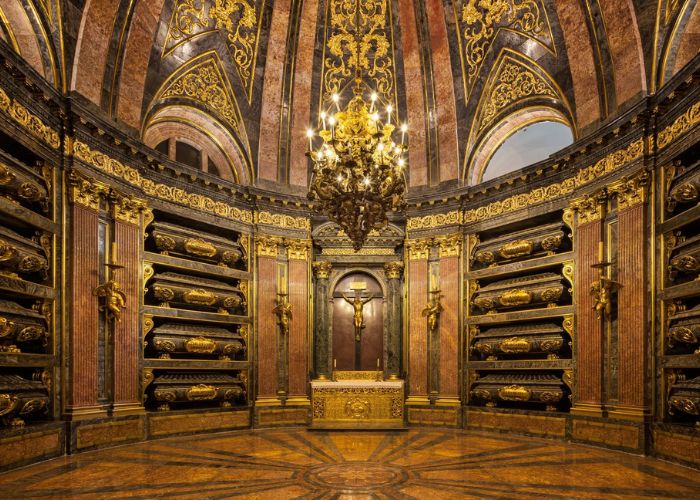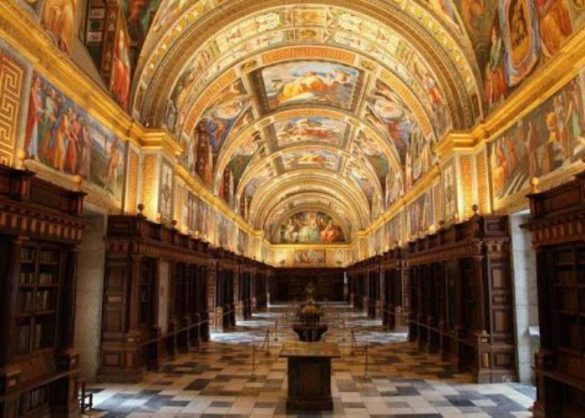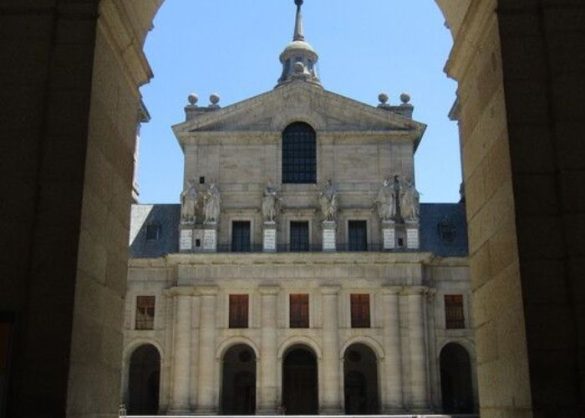SAN LORENZO DE EL ESCORIAL – The impressive Monasterio de San Lorenzo de El Escorial is located about fifty kilometres northwest of Madrid. This monastic palace from the second half of the sixteenth century is the most important Renaissance monument in Spain.
It has been on the UNESCO World Heritage List since 1984. The gigantic complex symbolises the immense power, wealth and ideological and cultural aspirations of the Spanish monarchs of the Golden Age. After Spain liberated itself from its Moorish occupiers at the end of the fifteenth century and Christopher Columbus discovered America, King Philip II inherited the most powerful empire in the world from his father Charles V in the mid-16th century. The Spanish Empire, to which the Netherlands also belonged, was led by an absolute monarch with a fanatically propagated Catholicism.
Philip II
Around 1551, the strict Catholic King Philip II (1527-1598) had chosen the centrally located Madrid as the new Spanish capital. Therefore, in 1563 he had a monastery palace built in the nearby Sierra de Guadarrama. This was in honour of his victory over the French at the Battle of Saint-Quentin. It was also a saving grace for a monastery destroyed in battle, on the exact day of the martyr Saint Lawrence (San Lorenzo in Spanish).
However, Philip II probably already had plans before his victory in Saint-Quentin for the construction of a grand monastery palace. Moreover, this would house a mausoleum for his late father Charles V (in Spain Carlos I) and a monastery where the Order of Saint Jerome could guard. over and pray for the deceased Spanish kings.
Before construction started, Philip II sent an architect out to travel around Europe. His task was to find out what was the largest religious monument. This was because the ruler wanted to be sure his palace would surpass that in grandeur. In 1584, when the Netherlands had detached itself from their Spanish rulers, the last stone was laid on the complex. This consisted of a mausoleum, basilica, library, royal palace and monastery.
Cradle of Spanish royal art property
The extensive Spanish royal art collection originated in the Monasterio de El Escorial. Philip II was a great art lover. He commissioned the best Spanish, Italian and Flemish artists to make paintings for the decoration of his palace. Absolutism and the Catholic faith were to be glorified in the images, other themes were not tolerated. The palace was covered with works of art by Titian, Jeroen Bosch, El Greco, Rogier van der Weijden and Francisco Ribalta, among others.
Jeroen Bosch
Philip II was particularly fond of the works of Hieronymus Bosch. In 1593 he had the world-famous triptych The Garden of Earthly Delights brought to his palace. Now the painting is one of the biggest attractions of the Museo del Prado in Madrid. The decoration of the whole complex consisted not only of the best paintings but also of Catholic sculptures by Cellini and Juan Bautista Monegro, among others. This made the Monasterio de El Escorial one of the main centres of European Catholic art.
The monastery of El Escorial
The order of Saint Jerome found shelter in the monastery of El Escorial for three centuries. As a result of the increasing secularisation in the nineteenth century, the number of monastic orders in Spain decreased drastically and in 1838 no more monastics were living in the abbey. The Spanish Queen Isabella II managed to restore the religious function of the monastery at the end of the nineteenth century, after which it was re-occupied in 1885. This time by the Order of the Augustinians, which has been housed there to this day.
The basic
In the middle of the complex is the basilica, which is connected to all other parts through this central location. The basilica is a masterpiece of Renaissance architecture. The design of the huge dome is based on the dome of the Vatican. The decorations depict holy figures such as martyrs, apostles and virgins. The main altar, which the king overlooked from his bedroom, is made of marble and other precious stones. The basilica gives access to the mausoleum, the final resting place of almost all Spanish kings from Charles V.

Library and museum
Philip II was not only a lover of art but also a passionate book collector. In collaboration with several well-known humanists of his time, the king built an immense library with more than forty thousand precious books and manuscripts, which are kept in beautiful wooden cabinets. The ceiling of the Salón Principal, where the library is located is decorated with beautiful frescoes. Finally, in the museum of the Monasterio de El Escorial, visitors can view Spanish, Italian and Flemish art from the fifteenth to the seventeenth century.
Click here for more information.





